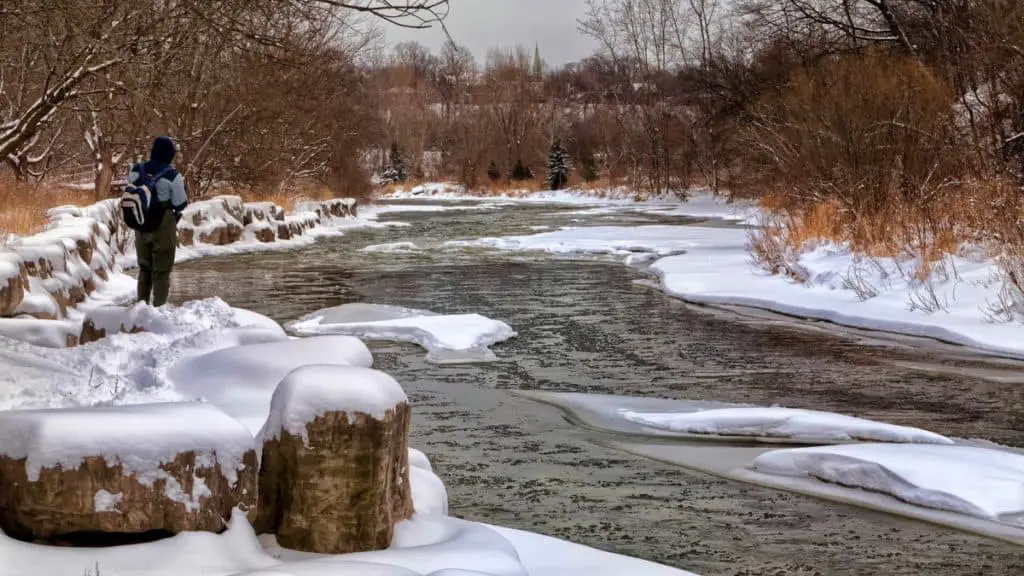
When you think of bass fishing, you typically think of fishing in a warm-weather setting. However, many anglers ditch their fishing habit when the winter chill sets in. Not so fast! Colder water plays a role as you plan your fishing day, but it is not a deal-breaker for catching fish.
Anglers often ask, “How do you catch bass in the winter?” Since bass are cold-blooded, their metabolism slows during the winter, so they react better to smaller baits coupled with a slower lure retrieve. Bass seek warmer water, so targeting areas of warm water in your lake or river is key.
Winter can be an excellent time to catch bass if you choose the proper techniques. By paying attention to a few key details, your bite-to-cast ratio and catch rate will improve.
The 9 Best Baits Catching Bass During The Winter
There are an overwhelming number of bait options and techniques, so selecting the right lure to catch bass in the winter may be a bit overwhelming. Check out these INSIDER recommendations for wintertime baits for bass.
1. Finesse Baits
Since fish are more lethargic during the winter, it’s time to break out your lighter tackle spinning rods and reels. (I’ve done a full breakdown on how to buy a spinning reel with recommendations. Check out the post here.) Finesse fishing for bass in the Winter is a great way to slow down to entice a bass to eat.
Common tactics include drop shot fishing and shaky heads. Using a finesse strategy, you’ll be able to present baits to bass in a way that will most appeal to them when they are inactive: SLOWLY. Drop shot rigs and shaky heads are not search baits.
This technique is best used once you locate fish with a moving bait or use your electronics.
2. Jerkbaits
Suspended soft plastic or hard jerkbaits are a favorite for catching bass in cold water. However, it is essential to remember to slow your cadence. Jerkbaits are built to resemble baitfish. Baitfish often die off during wintertime, so using a jerkbait can be a great way to imitate a dying threadfin or other baitfish if fished slowly. As with other baits, it is important to modify the cadence of your retrieve with a jerkbait during the winter and in cold water. Allow your lure to suspend without movement by pausing for a longer than usual time after each jerk or twitch of the lure.
3. Spoons
Fishing a spoon vertically has been a tried and true tactic for catching big wintertime bass for ages. Again, bass are looking for prey that is easy to catch. A fluttering spoon resembles a dying or slow-moving baitfish which is a perfect meal for a less aggressive bass looking for an easy target. This tactic is not the best tactic to FIND fish. Using spoons as a tool to catch bass is best after you have located specific fish (using a search bait or electronics).
4. Swimbaits
Worked slowly but steadily, swimbaits can be used to search for bass in areas known to hold bass during colder weather. They are an excellent bait for your cold-weather arsenal.
I really like the Yamamoto Zako Swimbait Artificial Fishing Bait. It’s one of the most lifelike swimbaits on the market. Check it out on Amazon by clicking the link above.
5. Jigs
Jigs can be used to target bass that you have already located via other methods. Jigs are, arguably, one of the best slow presentations for bass hugging cover. Jigs should be fished slowly and methodically for best results. Football head jigs are one of the most common jigs for wintertime bass fishing. Click on the picture below to visit Bass Pro for a unique twist to the traditional football jig. This jig puts bass in the boat!
6. Ned Rig
The Ned Rig has gained popularity recently and is an excellent bait for attracting and catching bass. Dead-sticking (fishing the bait with no movement imparted by the angler) is one great way to fish with this tactic especially when water temps drop. By dead sticking, you allow the bait to sit in the zone of waiting bass. The bait will flutter or move naturally as a result of natural underwater wave action. Another excellent tactic for fish that you have already located.
7. Crankbaits
Looking for a great way to search and find bass in the cold winter months? Try using a crankbait like the Rapala Shad Rap. As the water temp drops, so should your crankbait’s “wobble” or vibration. Again, less movement for less active fish. Likewise, you should slow your retrieve as the water gets colder. Read more about where to fish a crankbait by checking out this excellent article from Freaks with Fins.
8. Lipless Crankbaits
Lipless crankbaits are a staple for many avid bass fishermen. When slow-rolled, they can serve as great bait for finding fish. Once found, you can fish this bait like a spoon by presenting it with a “yo-yo effect” – snap it up and let it fall like a dying baitfish. Most lipless crankbaits rattle, so they attract attention through sound.
9. Spinnerbaits
Like a lipless crankbait, spinnerbaits can be either slow-rolled or fished like a yo-yo allowing them to be used as a search or “found” bait. Spinnerbaits offer a different presentation than lipless crankbaits because of the blades attached, which can reflect light and catch the eye of a bass versus sound attention (lipless baits).
How Do Bass Act During Cold Weather?
Cold water affects how bass behave during the winter months. While it is true that the bite can get tough, if you invest time into understanding how fish behavior changes in response to changing water temperatures, you have a great chance of finding and catching a good number of fish.
The temperature changes bass behavior when the water temp starts to dip below 50 degrees. As it continues to drop, the bass biology kicks in.
Since bass are cold-blooded, their body temperature changes as the water temperature changes. As their body temperature drops, bass tend to become slower and more lethargic. When they slow down, their eating habits change as well.
The reason that bass eat differently in the winter is related to a bass’s metabolism. As their body temperature cools, the metabolism of a bass slows down. As metabolism slows, bass need to eat less because they are not burning as many calories. However, bass still have to eat … they’re just pickier.
Bass are less active in cold water, making them less likely to move far to chase a bait. Because they are not as aggressive, slower-moving baits may be more tempting to wintertime bass. Additionally, it is usually beneficial to downsize your bait and lure options to elicit a bite when the water cools off.
Where do Fish Go During the Wintertime?
- Pay attention to a few key areas and patterns for finding bass in cold water.
- Go Deep! Look for the deepest water in your body of water, paying special attention to river and creek channel areas. Bass also love ditches where warmer, more stable water creates a better environment for them in colder months. Use Navionics at home to find key areas, then use your electronics at the lake to narrow things down and find fish. YOUR ELECTRONICS ARE KEY TO WINTERTIME BASS FISHING. I have run all brands on my boat but use Hummingbird Mega units. Check out the Helix 8 at Bass Pro by clicking the picture below. They are very user-friendly, and the picture is AMAZING.
- Use your electronics to find rocks. Bass love rocks for one simple reason: they hold heat. Rocks hold heat and release it into the water, making it a prime setting for bass looking for a warmer resting spot. Find an area with rocks, and you’ll likely find more than one fish because bass will very often congregate in places that hold heat. Shoreline riprap can also retain heat and be a great place to find bass looking for warmer water.
- Look for places where warm water may enter the lake. Power plants are one unique spot to find warm water. Also, check the backs of creeks where warmer water may flow in. Again find warm water, and you’ll find the fish.
- After a warming trend, fish may move up a bit to shallower water because it warms faster than deep. Moving away from typical deepwater spots to a close-by flat or a shallow edge may be your best bet.
- Look for areas of the lake that would typically serve as a spawning area. Once located, explore areas close to the spawning shallows that are deeper. Bass typically stay close to spawning areas throughout the year but transition in and out of bedding areas as weather changes, moving deeper as the water gets colder.
INSIDER TIP
Wind can play a HUGE role in your quest to catch bass in the winter. When fishing on a bright, sunny day, look for areas where the wind blows directly into a part of the lake. Wind blowing into an area means that the water at the top of the water column is mixing with the water in the lower levels of the column, so it warms the deeper water making it a better environment for bass (and fishing).
Secrets to Catching Bass in the Winter: A Summary
- Downsize to make presentations more appealing to finicky bass.
- Slow down. Bass are less active during this time of year and not as interested in hunting. Slow down to keep baits in front of bass for a longer period of time.
- Use your fishfinder’s thermometer to hunt for areas in the lake or river where the water is warmer. Find that water, and you’re likely to find bass.
- If you’re dealing with freezing weather, leave the micro guide rods home. They are more susceptible to ice build-up on the smaller line guides.
- Watch your weather forecast. If you notice a string of warmer weather days, plan a trip a couple of days AFTER that string starts. Water warms up slower than air, so the warming trend may take longer to impact the water temperature at your lake or river. By waiting, you’ll give the water a chance to warm up. This warming trend can often have a positive effect on bass fishing.
Final Word
Many people shy away from bass fishing in the winter. You can have great success with the tips and tricks above for catching wintertime bass. So grab your jacket and FISH ON!
